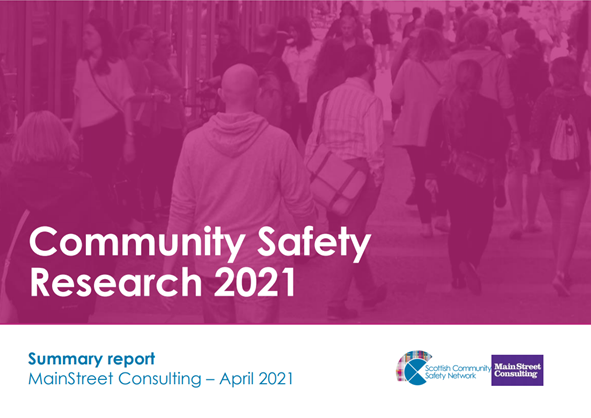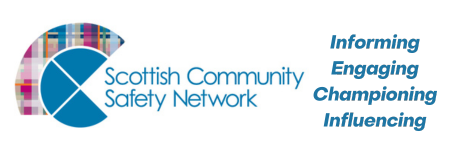
Today the Scottish Community Safety Network (SCSN) are delighted to publish the final reports (including a summary report) for four research projects we commissioned from MainSt Consulting around Community Safety earlier this year. These projects built on previous research into the emerging landscape and future opportunities for Community Safety.
The four projects focussed on:
- Describing the components of a modern and effective Community Safety Partnership (CSP), and the skills required to deliver it.
- Identifying what makes a safe community mapping how the relationships across the partners can support safer communities.
- Exploring the use of evidence in community safety and considering what evidence-informed planning might look like in Community Safety Partnerships (CSPs) of the future.
- Understanding what people with protected characteristics (or under-represented groups more generally) think about community safety in Scotland.
SCSN and MainSt Consulting held two seminars to discuss the research on 28th April and 6th May 2021.
Key messages from the research:
- Community safety in Scotland is complex: the breadth and depth of activity means that successful delivery relies on multiple partners and stakeholders working together at local, regional, and national levels
- Community engagement and empowerment is extremely important for community safety. The skills and techniques needed to maximise the potential for a more community-led approach need to be further developed.
- Data analysis is a constantly developing field which the community safety sector knows well. Further work is needed to ensure access to data, provide help to support the generation of new data (qualitative and quantitate) and overcome some perceived difficulties about restrictions on data sharing.
- The sector is multi-skilled and has been continuously exploring ways to get the best possible outcomes for community safety. Moving beyond the sharing of ‘best practice’ to the sharing of ‘best thinking’ would help empower a wide range of partners to find the ideas and approaches that are best suited to meeting the challenges faced by their communities.
- Community safety professionals are balancing responsive services with proactive strategies designed to make communities safer. Early intervention and prevention is recognised by the sector as important and there is even greater potential to work with communities to avoid unsafe situations developing or escalating is well understood.
- Community safety has mostly focused on geographic communities. The safety needs of communities of interest are often significant and warrant a co-ordinated national approach to ensure that people with particular safety needs are not unduly unsafe.
Lorraine Gillies, Chief Officer of the Scottish Community Safety Network said that “We are delighted to be publishing this research today at this critical time for Community Safety. The research took place during the COVID19 pandemic and its associated lockdowns as well as coinciding with widespread Black Lives Matter protests and increased focus on women’s safety. All of these factors heighten the importance of Community Safety. We hope this package of resources will play an important part in providing Community Safety practitioners with the evidence to continue to move forward and adapt to new challenges. The research provides a range of recommendations that SCSN will collate and synthesise to inform future planning and events to ensure that the field of Community Safety remains a responsive, flexible and inspiring area to work within.”
David Welsh, of Main Street Consulting, said:
“We were delighted to work with SCSN colleagues on these projects, and we’re confident that they will support the future development of the network and its work across Scotland.
There’s no doubt that community safety here is complex: the breadth and depth of activity (as shown in the Complexity Map we worked on together) means that successful delivery depends on multiple partners and stakeholders working together at local, regional, and national levels. While there are undoubted challenges, there are real opportunities too.
We really enjoyed working with dozens of community safety professionals and partner organisations over the past few months – and we’d want to thank them for contributing so much when they themselves were busy. It was also a privilege to be involved in some initial conversations with traditionally under-represented groups; we’re pleased that SCSN is committed to continue to engage with them and other people with protected characteristics. The whole sector will benefit from those experiences.”
Next steps
The SCSN intends to follow up with other organisations that expressed an interest in participating in the project on understanding what people with protected characteristics (or under-represented groups more generally) think about community safety in Scotland, but for whom capacity or timing did not allow active involvement at this time – notably with older people, young women, people from minority ethnic backgrounds, people identifying with religious communities and with groups representing Gypsy/Traveller and Roma communities. Initial contacts have been made and SCSN plan to continue these conversations later in 2021 to develop a richer understanding of these diverse experiences and what the response from public services and communities might be. Please get in touch with josh.box@scsn.org.uk if you would like to find out more and / or share your reflections on the research.
Downloads
- You can download the Summary Report here.
- Project 1: Partnership working including skills and learning needs
- Project 2: What makes a community safe?
- Project 3: Evidence Informed Planning
- Project 4: Community Safety for groups with protected characteristics
- Research Bibliography
Webinar videos
You can view the Webinar videos on this project here:
